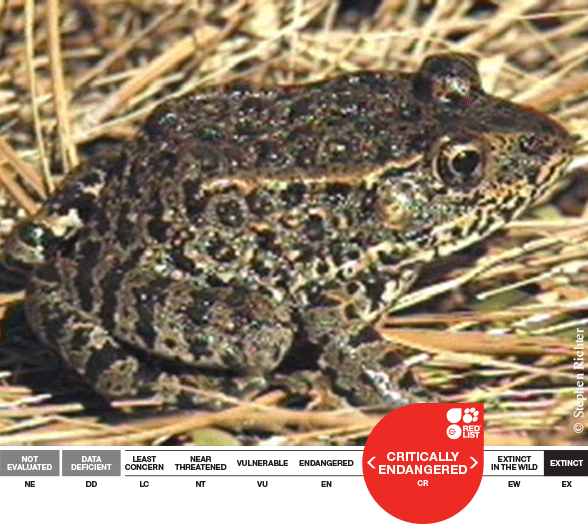 The Dusky Gopher Frog, Rana (Lithobates) sevosa, is listed as ‘Critically Endangered’ on IUCN Red List of Threatened Species TM. This North American species was historically found from southeastern Louisiana through southern Mississippi to southwestern Alabama; but it is now only found in two localities in Harrison and Jackson counties, Mississippi. The Dusky Gopher Frog is most known for its use of two distinct habitats – burrows made by gopher tortoises, small mammals, or dead trees during the non-breeding season and ephemeral ponds during the winter breeding season.
The Dusky Gopher Frog, Rana (Lithobates) sevosa, is listed as ‘Critically Endangered’ on IUCN Red List of Threatened Species TM. This North American species was historically found from southeastern Louisiana through southern Mississippi to southwestern Alabama; but it is now only found in two localities in Harrison and Jackson counties, Mississippi. The Dusky Gopher Frog is most known for its use of two distinct habitats – burrows made by gopher tortoises, small mammals, or dead trees during the non-breeding season and ephemeral ponds during the winter breeding season.
 |
The major cause of decline for Dusky Gopher Frogs has been habitat loss to urbanization, logging, lack of fire, and degradation of breeding wetlands. Additionally, because of its small population sizes, this species is experiencing loss of genetic diversity and is particularly susceptible to prolonged droughts, local pollutants, and diseases (particularly an undescribed mesomycetozoean), and introduced or natural predators. In 2009, the U.S. Department of Fish and Wildlife (USFW) estimated that less than 100 adults remain in the wild.
As of 2004, a ‘Gopher Frog Recovery Team’ has managed conservation strategies for Dusky Gopher Frogs, including supplementing ponds in dry years, adding additional ponds, supplementing populations with larvae head-started in cattle tanks, captive rearing, and treating ill larvae. In 2009, a recovery act was established by USFW that also included long-term monitoring of known breeding sites, captive rearing of tadpoles, developing a captive breeding program, translocations, and restoration of habitat. In the same year, the Memphis Zoo in Tennessee, USA first bred the species in captivity. A Regional Studbook was completed in 2011, and an AZA (Association of Zoos and Aquariums) Population Management Plan was published in 2012.
Also in 2011, the USFW designated critical habitat in St. Tammany Parish, Louisiana, and in Harrison, Jackson, and Perry Counties, Mississippi, for Dusky Gopher Frogs. Upland habitat and wetland restoration has begun in many of these sites in Mississippi. Despite these advances, legal controversy and lack of expanding frog populations signal that conservation efforts need to persist.
Submit your observations of this species to iNaturalist and they will appear on this map. Learn more about this species on Amphibiaweb.
More Amazing Amphibians here.
Produced in partnership with:
 |
||
 |
 |
 |
 |
 |
 |
If your organization would like to be involved with the Amazing Amphibians program please email: amazing@amphibians.org.







